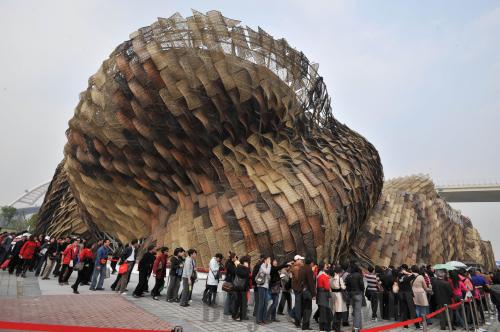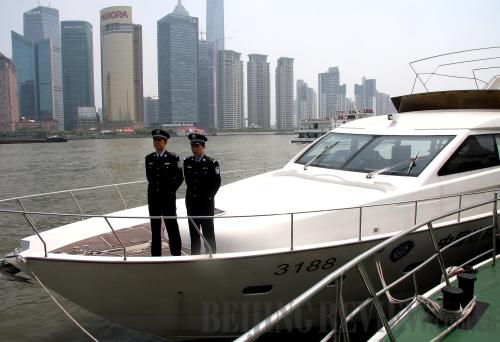|
 |
| POPULAR VENUE: People queue up at the entrance to the Spain Pavilion during the test run of the Expo site on April 23( GUO XIAOYONG) |
Shanghai, one of the most populated cities in the world's most populous nation, knew it had the largest ever World Exposition to prepare for more than two years prior to its opening, when a record number of countries and international organizations confirmed their participation.
A total of 246 countries and international organizations take part in World Expo 2010, far exceeding the record of 172 participants created by Expo 2000 in Hannover. The organizers of the Shanghai Expo had long expected the event to attract around 70 million visitors, or more than 400,000 per day, during its 184-day run.
The opportunities and challenges of Shanghai's grand, international fair have kept urban planners busy for years in the lead-up to the Expo, upgrading the city's amenities and traffic facilities to ensure the Expo is a success.
Logistical upgrades
|

|
|
GUARDING THE WATERS: A patrolling boat is anchored at a dock on the Bund. The boat conducts security checks on ships traveling on the Huangpu River during the Expo (CHEN FEI) | The 2010 Expo site is located in the heartland of Shanghai, on the waterfront area between the Nanpu Bridge and Lupu Bridge, along both sides of the Huangpu River. Covering a total area of 5.28 square km, the site encompasses 3.93 square km on the east side of the river and 1.35 square km on the west side.
Since 2007, Shanghai has been engaged in a series of projects to improve its traffic infrastructure as part of preparation efforts.
Shanghai's airports, which will be able to handle 260,000 passengers per day, as well as the railway system and long-distance buses, are fully prepared to handle all Expo tourist flows from other parts of China and abroad, said Shen Xiaosu, Deputy Director of the Shanghai Urban Construction and Communications Commission, at a press conference on April 15.
A 360,000-square-meter new airport terminal in the Shanghai Hongqiao International Airport commenced operation on March 16, and will eventually handle more than 90 percent of all flights to the airport.
On the first day of its operation, a total of 11 domestic carriers moved their operations to the new terminal. The terminal is part of the 26-square-km Hongqiao traffic hub, which includes a railway station and a long-distance bus terminal.
The extension of Shanghai's subway Line 2, which connects to the new terminal, also commenced operation on March 16.
As Shanghai's 11th subway line started trial operation on April 10, the city had more than 420 km of metro routes in service, the longest among all Chinese cities. According to Shen, metro routes in Shanghai are expected to facilitate more than 6 million trips per day during the Expo, and more than half of Shanghai residents choose metro lines as their first choice of daily transportation.
Shen said the city now has 145 km of high-speed roads in its central districts—a 25-percent increase compared to 2008. Shanghai also has eight highways that link it to neighboring cities, with a total length of 776 km.
According to a detailed traffic management plan for dealing with crowds during the Expo released by the Shanghai authorities in January, visitors can reach the Expo site within 90 minutes from Shanghai's farthest suburbs via buses and subways. Visitors can travel to the Expo by metro lines, regular buses, special Expo coaches, and boats or taxis. The plan estimates that 90 percent of attendees will travel to the site via public transportation.
"We invested a total of 169.3 billion yuan ($24.9 billion) into major infrastructure projects to prepare Shanghai for the Expo in 2009, achieving a substantial annual increase. This year investment in the area will reach a total of 100 billion yuan ($14.7 billion)," said Shen.
Enjoying Shanghai
Cheng Meihong, Deputy Director of the Shanghai Municipal Tourism Administration, said at a press conference on April 16 that the effects of the Expo tourism boom were felt as early as the first quarter of 2010. In the first three months, the average occupancy rate of hotel rooms in the Pudong District, where the majority of the Expo site is located, registered 56.3 percent, the highest amongst all of Shanghai's central districts, and a rise of 12.9 percent year on year.
According to the local tourism administration, Shanghai has a total of 334,000 hotel rooms with 557,000 beds, including 98,000 beds in star-rated hotels. Expo tourists can also stay at one of 100,000 hotel rooms in Shanghai's neighboring cities, which are a two-hour drive from Shanghai. To meet the demand for accommodation, the city has launched a home-stay program, which has registered 700 families.
| 